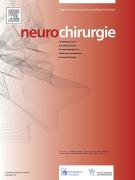Endoscopic 3rd ventriculocisternostomy: Procedural complications and long-term dysfunctions? - 09/11/13
Ventriculocisternostomie endoscopique du troisième ventricule : complications procédurales et dysfonction à long terme ?
 , S. Derrey a, E. Gérardin b, A. Borden c, P. Fréger a, F. Proust a
, S. Derrey a, E. Gérardin b, A. Borden c, P. Fréger a, F. Proust aAbstract |
Background and purpose |
The endoscopic third ventriculostomy (ETV) has become the treatment of choice for managing non-communicating hydrocephalus. The aim of this study was to evaluate the efficacy and the morbi-mortality of this procedure and its long-term outcome.
Patients and methods |
This retrospective study involved 82 consecutive patients treated for non-communicating hydrocephalus by ETV, in a single centre, between June 1999 and November 2008. The main criterion of efficacy was clinical improvement with shunt independence. The secondary criteria were the ventricular size (third and lateral ventricles) outcome and the procedural morbidity and mortality. In order to determine the predictive factors of dysfunction, a uni- and multivariate analysis was conducted.
Results |
Divided in two groups, the overall success rate was 65.4% in the paediatric group (n=26) and 83.9% in the adult group (n=56), after respectively a mean follow-up of 59.1±36.7 and 49.3±27.7 months. A procedural complication occurred in 5 patients (6.1%), with no procedure-related death. The predictive factors of ETV failure were an infectious aetiology and an age less than 16. Changes in ventricular size and success rate were independent.
Conclusions |
ETV is an effective procedure at long-term for the management of non-communicating hydrocephalus with low morbidity. Therefore, it should be considered as first-line treatment. Cerebrospinal meningitis infection and young age both expose patients to possible dysfunction.
Le texte complet de cet article est disponible en PDF.Résumé |
Objectifs |
La ventriculocisternostomie endoscopique du plancher troisième ventricule est devenu le traitement de choix des hydrocéphalies non communicantes. Le but de cette étude était d’évaluer l’efficacité de cette procédure, la morbi-mortalité qui lui était associée et son suivi à long terme.
Patients et méthodes |
Cette étude rétrospective comprenait 82 patients consécutifs traités pour une hydrocéphalie non communicante par ventriculocisternostomie endoscopique, dans un centre unique, entre juin 1999 et novembre 2008. Le principal critère d’efficacité était l’amélioration clinique sans nécessité d’implantation d’une dérivation interne de LCS. Les critères secondaires étaient la taille des ventricules (ventricules latéraux et troisième ventricule), l’évolution à long terme et la morbi-mortalité procédurale. De plus, afin de déterminer des facteurs prédictifs de dysfonction, une analyse uni- et multivariée a été menée.
Résultats |
La population a été scindée en deux groupes : adultes et enfants. Le taux de succès dans le groupe pédiatrique (n=26) était 65,4 % et dans le groupe adulte (n=56) 83,9 % après un suivi moyen de respectivement de 59,1±36,7 et 49,3±27,7 mois. Une complication procédurale est survenue chez cinq patients (6,1 %), sans mortalité rapportée au geste chirurgical. Les facteurs prédictifs d’échec étaient une étiologie infectieuse à l’hydrocéphalie et l’âge du patient inférieur à 16ans. La modification de taille des ventricules et le succès de la procédure étaient indépendants.
Conclusion |
La ventriculocisternostomie endoscopique du plancher du troisième ventricule est une procédure efficace à long terme pour la prise en charge des hydrocéphalies non communicantes. Avec une faible morbidité, cette procédure devrait être employée en première intention tout en considérant que l’étiologie infectieuse et l’âge inférieur à 16ans sont deux situations qui exposent à un échec.
Le texte complet de cet article est disponible en PDF.Keywords : Endoscopic third ventriculocisternostomy, Non-communicating hydrocephalus, Long-term outcome, Complications
Mots clés : Ventriculocisternostomie endoscopique du troisième ventricule, Hydrocéphalie non communicante, Suivi à long terme, Complications
Plan
Vol 59 - N° 4-5
P. 165-170 - août 2013 Retour au numéroBienvenue sur EM-consulte, la référence des professionnels de santé.

